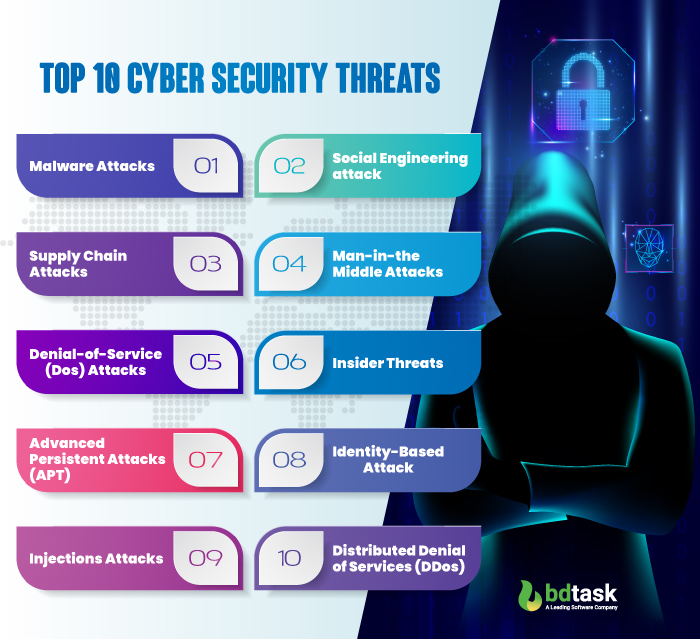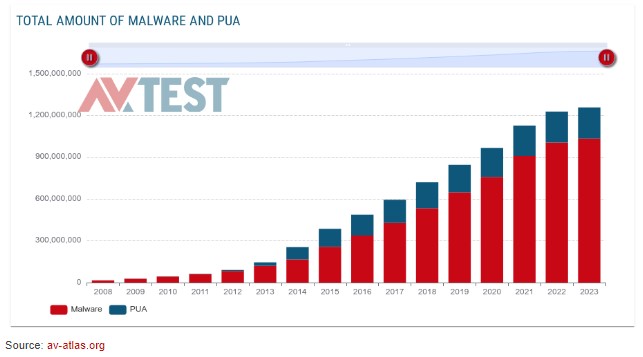Top 10 Types of Cyber Threats in Cyber Security with Solutions

As technology continues evolving, it also outgives a bucket of cyber threats to individuals and organizations. Many innocent individuals and companies have been affected by this bucket of old and new types of cyber threats in cyber security.
Since we carry on with the ride of types of cyber threats, some even lose their sensitive information and credentials to hackers. However, having some basic and advanced knowledge about cyber attacks can help mitigate cyber threats.
In this blog, we will dive into different types of cyber threats in cyber security in detail. It will cover an introduction to cyber threats and a list of cyber security threats and solutions with cyber threat examples. Therefore, you can recognize them and save your company, yourself and many others.
What is a Cyber Threats?
Cyber or cybersecurity threats are malicious attacks by an individual or organization intended to damage data, steal confidential data, or gain access to the computer network to disrupt digital life.
Cyber threats include attacks from computer viruses, data breaches, denial of service and other attack vectors. They also refer to the possibility of cyber attacks to steal information, technological assets, intellectual property, or any other form of sensitive data.
Common Sources of Cyber Threats
Before going into the types of cyber threats, we should know about the sources of cyber threats to raise awareness.
Cyber threats can come from a variety of sources, such as hostile nation-states and terrorist groups. This is why implementing robust cybersecurity solutions for government entities is essential to protect sensitive data and maintain national security against such diverse and persistent threats. Also, these cyber threats can originate within an organization by trusted users who abuse their privileges or by unknown parties from remote locations.
Here is a cyber threat actors list that represents some types of threat actors against organizations,
- Hackers
Hackers develop a variety of attack techniques to attack different organizations. Usually, hackers do that for personal gain, financial gain, revenge or political purposes. Sometimes, they get inspired to show off their improvement in criminal activities in the hacker community.
- Terrorist Groups
Terrorists conduct cyber attacks to destroy or abuse critical infrastructure, threaten national security, disrupt economies and harm citizens.
- Nation states
Hostile countries plan cyber attacks against local companies and organizations to disturb communications and cause disorder and damage.
- Criminal Groups
Criminal hacker groups want to break the computing system of organizations for economic benefits. They can use spam, spyware, phishing and malware to steal confidential data for extortion and online scams.
- Malicious Insiders
An individual or a group of employees who are part of the companies with legitimate access to company assets. However, they abuse their privileges to steal data and information or damage computing systems for financial or personal gain.
- Corporate Spies
Corrupted corporate organizations target the intentional exploitation of a vulnerability or a situation and method that may accidentally exploit a vulnerability.
- Hacktivists
Hacktivists are a subset of hackers who adversely impact the organizational operations of individuals or nations via unauthorized access, destruction, disclosure or denial of service. Their main aim is to spread political propaganda rather than disrupt organizations.
10 Types of Cyber Threats in Cyber Security

Cyber security issues are rising daily, in sync with the digitization of business and technology. While there are dozens of different types of cyber threats in cyber security, here is a list of 10 common types of cyber security threats in cyber security with examples.
1. Malware Attacks
Malware is a common type of cyberattack among the kinds of security threats to organizations. It includes viruses, trojan viruses, ransomware, worms, spyware etc. Attackers often use malware to get into users' devices through social engineering.
Malware generally infiltrates a system via a link from an untrusted website, email, or unwanted software download. In other cases, they can use browser or operating system vulnerabilities to install themselves without the users' consent.
Once installed, malware can collect sensitive data, monitor user activities, and send data to the attackers. In addition, they can assist the attacker in penetrating other targets within the network. Further, they can even destroy data, block access to network components or shut down the system altogether.
Here are some common types of malware attacks,
- Viruses: Malicious software can inject code into an application and computer. When the application runs, the malicious code can execute and cause damage to systems, steal data, corrupt files, and much more.
- Trojan Viruses: A Trojan poses as an innocent program hiding in apps, games or email. When a user downloads the trojan, it can attack a system. It even allows attackers to gain control of the user's device.
- Ransomware: Ransomware, meaning in cyber security, is the most dangerous type of malware in cybersecurity. Unless a ransom is paid, it can deny access to users or organizations to own their data and systems. Various types of ransomware are WannaCry, Cryptolocker, Ryuk, Petya and many more.
- Worms: Worms are self-replicating, similar to viruses, but they do not need to be attached to another application. After being installed in the network, they can conduct various attacks, including distributed denial of service (DDoS).
- Spyware: Spyware is a form of malware that enables actors to access confidential data, payment details and credentials. It can affect personal information, mobile phones and desktop applications.
- Cryptojacking: Cryptojacking is used on victims' devices without their knowledge to track their computing resources to generate cryptocurrency. This malware can affect the stability of the system and become slow.
- Wiper Malware: This aims to damage data and systems. Generally, they intend to send political messages or hide hacker activities after data exfiltration.
- Fireless Malware: This malware denied software installed on the operating system. It makes native files into malicious functions challenging to detect because files are recognized as legitimate.
- Rootkit: This malware is injected into applications, firmware, operating systems or hypervisors. For this reason, the actor can get complete access to the control of the computer and deliver other malware.
- Adware: Adware is similar to spyware. It allows actors to track the victim's behaviour pattern and interests without their consent to send targeted advertising.
- Application or Website Manipulation: This can happen from broken access controls and security misconfigurations through injection attacks and cryptographic failures. Once it is established through service, more malware and credential, APT attacks are launched.
Example: According to the email security report, Mimecast reported that 51% of organizations experienced ransomware attacks. In 2021, this statistic had risen to 61%.
Solution: A proactive cyber security approach is just needed to prevent it. Users should have common precautions, including regular computer and application patching, using endpoint protection software, multi-factor authentications, strong passwords, and protection against malicious emails.
In addition to these measures, incorporating application whitelisting ensures that only approved applications can execute, effectively shielding against unauthorized or malicious software.

(Source:av-test)
2. Social Engineering Attacks
Social engineering works to access users' sensitive information or unwittingly installs malware on their devices through manipulation and trickery. These cyber threats can be presented in person; tough phishing campaigns are usually attack vectors of social engineering. For example, threat actors pose as legitimate actors and ask for passwords.
Here are some social engineering attacks,
- Phishing: Phishing is a top information security threat sent by attackers as fraudulent emails that look to come from a trusted source. The email may urge the user to act or click on the malicious link, leading them to access the sensitive information. Phishing often targets as many users as possible, but it also can be precisely personalized. For example, "spear phishing" targets a specific user, while "whaling phishing" targets a step ahead of high-profile individuals like CEOs.
- Baiting: Threat actors manipulate targeted users using social engineering traps, such as with a promise of a lucrative offer or gift. Once the targets click on traps, they unintentionally install the malware into their devices and provide the attackers with confidential data, such as credentials.
- Pretexting: It is similar to baiting. The attackers pressure the users and lie to them to access privileged data. Also, a pretexting scam may involve impersonating someone with authority. For example, a police officer's involvement will compel the victim to comply.
- Vishing: Vishing attacks use phones to get the targets to disclose their sensitive data or financial benefits.
- Smishing: Attackers send text messages to deceive the users, pretending to be your trusted service like a bank. Due to this, they can access sensitive data such as passwords, usernames or credit card numbers.
- Tailgating: This occurs when an unauthorized actor follows authorized personnel to enter a secured building. For example, a staff with legitimate access has opened a protected door for unauthorized actors' access.
- Piggybacking: An authorized person provides physical access to another person who "piggybacks" off the person's credential data. For example, an employee may accept access to someone as a new employee who steals their confidential data and credentials.
- Whaling: Threat actors target high-profile employees to track confidential information, for example, the chief executive officer (CEO).
- Scareware: Threat actors trick the victim into thinking their device is infected. Next, they offer solutions to victims to download and install, which is actually malware.
- Diversion theft: Threat monsters trick delivery service companies by giving their customers the wrong location information to intercept the transaction.
- Honey trap: Threat actors use social engineers to make fake identities to interact with the target. Then, they create an online relationship with the target to grab sensitive information.
- Pharming: Online fraud groups scam targets by installing malicious code into victims' computers. This code manipulates the victims to provide personal data.
Solution: Usually, a common-sense approach is the best defense to it. Before clicking on any link via email, think carefully and pay deep attention. Usually, authentic emails from organizations do not require personal information. So, if it requires personal data, there is malicious intent. So, above all, don't click on any suspicious link from an unknown source.
3. Supply Chain Attacks
A supply chain attack is a new cyber attack on software developer organizations and vendors. We know that attackers always look for vulnerabilities in cyber security supply networks. These vulnerabilities can be network, operating system, and human vulnerabilities for individuals, organizations, resources, and technologies involved in software development and sales.
The attacker mainly aims to infect legitimate applications and spread malware via updates, source code or development.
Supply chain attacks exploit the trust of third-party vendors of organizations, mainly updates and patching. For this reason, a supply chain attack is dangerous because the vendors are unaware that their applications or updates are infected with malware.
Examples of supply chain attacks are,
- Compromise of building tools or development infrastructure
- Malware codes are pre-installed on devices like mobile phones, USBS, etc.
- Settlement of devices owned by privileged third-party vendors.
- Malicious code is sent as automated updates on hardware or firmware components.
Solution: To mitigate the supply chain attacks, implementing a robust vendor risk management is the solution. This vulnerability management solution can rescue a business from becoming a vulnerable link. They can identify security weaknesses that could serve as attack vectors in the supply chain.
4. Man-in-the-Middle Attacks
Man-in-the-middle attack involves intercepting the communication when users or devices access an application over the internet. Attackers can eavesdrop on the transmission, placing them between the users and the target server. Then, they impersonate each party participating in the communication and steal confidential data.
Types of MitM attacks are,
- Email Hijacking: Attackers defraud the email address of a legal organization, for example, a bank or delivery service, to manipulate users. Then, they use it to give up sensitive data or transfer money to them.
- DNS Spoofing: Attackers spoof the Domain Name Server to divert traffic from the authentic site to a malicious website, which poses as a legitimate site.
- IP Spoofing: Attackers spoof IP addresses to pretend to be legal websites. And through this, they connect with users and deceive them.
- HTTPS Spoofing: Attackers use "HTTPS" in the URL to cover the malicious nature of the website. Then, they trick the browser into thinking that the website is safe for browsing.
- Bluetooth Attack: Bluetooth is often open mode, and through this, many malware attacks on phones steal credentials to personal information and even drop contact cards.
- Wi-Fi Hijacking: Attackers set up a Wi-Fi connection but pose as legitimate actors to connect with users. The attacker can monitor the user activity and intercept data through this connection.
- Replay Attack: Cybercriminals eavesdrop on network communication and replay messages, pretending to be the user.
Solution: To protect organizations from MitM attacks, strong encryption and HTML5 should be used on access points.
5. Denial-of-Service (Dos) Attacks
A denial-of-service attack is an attack that can shut down a machine or network system, making it inaccessible to its users. DoS attacks conduct this with a large traffic volume or by sending information that triggers a shutdown.
However, some DoS attacks include are,
- HTTP flood: Attackers use HTTP requests that act as legitimate to overwhelm a website or an application. This technique typically forces a target system to allocate as many resources as possible without requiring high bandwidth.
- UDP: A remote host is sent at random ports, flooded with User Datagram Protocol (UDP) packets. Then, this technique forces the host to search for the solution for the affected ports so that the attacker can use the host resources.
- ICMP flood: Consuming both inbound and outgoing bandwidth, ICMP Echo request packets overwhelm the target, so the servers may try to respond to each request. However, the servers cannot cope with the demand; consequently, the system slows down.
- NTP amplification: This application is accessible to the public and can be exploited also by an attacker. By this technique, an attacker can send a large volume of UDP traffic to control the targeted server with a high volume, high-bandwidth DDoS attack.
Example: According to the latest cyber attack news, Indian IT services have been struggling with a 'security event' named "Infosys McCamish Systems". Because of this, their firms' application becomes unavailable in their US unit.
Solution: to prevent this attack from your device and server, you should run a traffic analysis to identify malicious traffic. Always be careful of warning signs, for instance, network slowdown, intermittent website shutdowns, etc., and take necessary steps as soon as possible.
6. Distributed Denial of Services (DDos) Attacks
Distributed Denial of service attack is similar to Denial of service attack. Like DoS, it aims to disrupt a computer network or system by flooding it with superfluous requests from a botnet.
Some types of DDoS attacks are,
- Botnets: Attackers use these bots to attack users. Bots carry out DDoS attacks; in large bots, attackers can include millions of devices and shoot at a large scale.
- Smurf Attack: This occurs when ICMP requests are sent to the victim's IP address, which originates from a 'spoofed' IP address. So attackers can automate this process and perform it in the target system.
- TCP SYN flood attack: The target system is flooded with overwhelming requests, which forces the target system to time out. Consequently, the target device needs to respond to legitimate users.
Example: A major DDoS attack occurred on the internet in February 2020 to Amazon Web Services (AWS).
Solution: The standard way of DdoS prevention is to use a firewall to detect whether requests sent to your site are legitimate. Allowing regular traffic to flow can discard the imposter requests.
7. Injections Attacks
An injection attack is the top web application security risk of an attacker injecting malicious code. Then, this malicious code is injected into a vulnerable computer network or web application. As a result, sensitive information is exposed, and DOS attacks can be executed.
There are some primary Injection attacks; they are,
- SQL Injections: This attack occurs when the hacker hacks the company database to upload malicious SQL codes. Due to this, the hacker can monitor the database and steal sensitive information.
- OS Command Injection: Attackers want to execute the operating system or take over the plan to exfiltrate OS data. Besides, they input commands exploiting a command injection vulnerability.
- Code Injection: Attackers inject code into a vulnerable application. Consequently, the web server executes the malicious code as a part of the application.
- LDAP Injection: This attack is severe because LDAP servers store victims' personal data, accounts and credentials. Attackers inject characters to alter LDAP queries in a vulnerable system that uses unsanitized questions.
- Cross-site Scripting: Attackers input a string of written text containing malicious Javascript to the target. Then, the target browser executes the code to enable the attackers to redirect users to malicious websites and steal users' sessions.
- XML eXternal Entities (XXE) Injection: XXE is the top web application security risk. This attack uses specially constructed XML documents and is different from other attack vectors because it exploits inherent vulnerabilities in legacy XML parsers, which can be used to traverse paths.
Solution: What's more, container security helps by isolating different parts of an application, ensuring that if an attack occurs, it’s confined to a single container and doesn’t spread to other areas of the system.
8. Identity-Based Attack
Identity-based attacks are severe attacks that are difficult to detect. Because the attacker pretends to be a user when the valid users' credentials have been compromised. So, it is often challenging to differentiate between the user's typical behaviour and the hacker using traditional security measures and tools.
Here are some common identity-based attacks,
- Pass-the-hash-attack: Attackers steal a 'hashed' user credential and then use it to open a new user season on the same network. In these attacks, the threat actor doesn't need to decrypt the hash to gain access to the system.
- Golden Ticket Attack: Golden Ticket Attack is a similar form of paa-the-hash-attack. Adversaries attempt to gain unlimited access to an organization's domain using this attack. For example, Mimikatz attacks often use this attack vector.
- Password Attack: A hacker can gain access to the password by sniffing the connection of an individual network using social engineering guessing or accessing a password database. However, attackers can also guess a password systematically or randomly.
- Brute Force Attack: Attackers use brute force to encrypt the user's personal information. In this case, they try many different password combinations of usernames, jobs, family, etc, until they finally succeed in this attack.
- Silver Ticket Attack: When an attacker steals an account password, a forged authentic silver ticket is created. With the silver ticket attack, a generated key can be encrypted and enable access to resources for the specific service.
Solution: Some precautions can be taken to stop this attack. For example, use alphanumeric solid passwords, don't use the same password for multiple accounts or websites, update your password and don't expose your password hints.
9. Advanced Persistent Attacks (APT)
When attackers gain access to a network but remain disclosed for an extended period. They may exfiltrate sensitive data and purposely avoid detection by the security staff. Generally, this attack is launched against nation-states, large corporations, or precious targets.
Here are some APT-based attacks included,
- Abnormal Activity: Unlike typical activities in legitimate user accounts, abnormal activity indicates advanced persistent attacks.
- New Account Creation: The attacker creates an identity or credential on the network with elevated privileges.
- Backdoor Malware: This method helps APT enable them to have long-term access.
- Abnormal Data Files: Abnormal data files have a few malware attributes to assist in an exfiltration process, for example, illegal bank transactions, defective products, and natural disasters.
- Unusual Database Activity: Massive amounts of data suddenly increase in database operations.
Solution: The primary solution to this attack is to keep updating your operating system regularly. Plus, use trusted and legitimate Anti-virus protection software to remove vulnerabilities in your system.
10. Insider Threats
Insider threats are the most severe actors that don't involve a third party but an insider. In such cases, insiders can be individuals or groups who do not need to have higher degrees. Because they are authorized persons who know everything and access data to exploit sensitive data.
In addition, insider threats are perilous to predict and detect. Moreover, they quickly gain access to restricted areas. By this, they can make security changes or deduce the best time to exfoliate an attack.
Example: However, there are various types of insider threats in cybersecurity. The internal threats include second streamers, malware installations, careless employees, lone wolves, disgruntled employees, collaborators, and many more. Gaining expertise in managing these threats with the help of microsoft az-500 practice test dumps can significantly enhance your skills.
Solution: Here are some prevention measures against insider threats.
- The organization should have an organized security protection and cyber threat intelligence team for outsiders and employees.
- Next, companies should maintain security awareness.
- Hence, organizations should have limited access depending on their job roles and accessibility.
- Plus, companies should train employees to detect insider threats.
The Verdict
In this digital world, cyber-attacks are ever-increasing, with different attacks for different purposes. Moreover, cyber adversaries use advanced levels of attacks when exploiting victims. These new measures have forced organizations to take cybersecurity prevention seriously.
However, by staying vigilant and embracing robust technology, we can mitigate these types of cyber threats in cyber security. Organizations should upgrade security analytics for each attack and basic IT hygiene and operation tools, skills, and processes as solutions for cyber threats.










